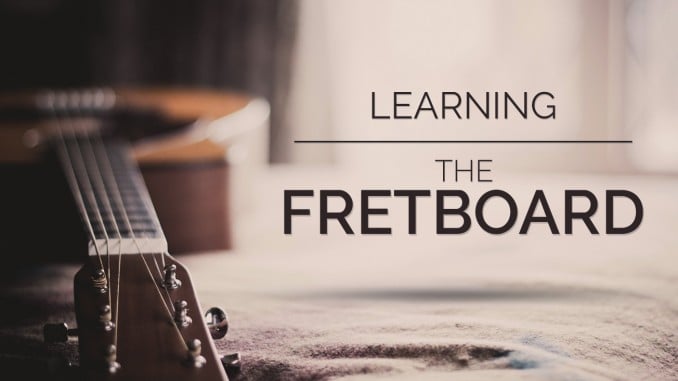
Learning the fretboard is a challenge that this lesson will help you tackle efficiently. Did you know that a 22-fret guitar contains 138 notes? It is a huge task that challenges both beginner and experienced guitarists. This lesson will tell you why some people teach it the wrong way (inefficiently and boring).
Why You Should Learn the Fretboard
You should learn the fretboard for one simple reason. You want to play faster!
Usually, when people talk about speed, they talk about the physical aspects of learning the guitar. Usually, I think of shredders finger tapping their way to insane flurries of notes. Shredding takes a lot of practice, but it is a different type of speed.
When you learn the fretboard, you play faster because you can instantly recall a note. Instant recall allows you to find and play any note as fast as possible. It is a mental speed, which allows you to decide, find, and play faster.
Why Deriving the Fretboard Doesn’t Work
Most guitarists claim to know the fretboard because they can find any note. Many songs have a tempo of 120bpm, which is 2 seconds per measure.
- Whole note = 2 seconds
- Half note = 1 second
- Quarter note = 1/2 second
- Eighth note = 1/4 second
- Sixteenth note = 1/8 second
You need to recall notes in fractions of a second! This is why knowing how to find any note does not work. Without instant recall, you cannot keep up!
How to Learn the Fretboard
Learning the fretboard is not hard, but it takes practice. Most guitarists find the task boring because they learn it the wrong way. On top of that they try to take shortcuts that don’t work! The best way to learn the fretboard is by incorporating multiple ways of remembering the note. This is not only more interesting, it is more effective.
Use Associations
The human brain remembers by using associations. When you play a note, you think of the note you want. You find it on the fretboard. You hear the note. You see the fretboard. All these items can be associated with each other to form multi-dimensional exercises. Later, I will give you exercises that associate what you see, hear, and feel to maximize your efficiency.
Practice to Remember
Did you ever cram for an exam and forget what you learned? When you try to cram to learn the fretboard, you will forget it. Your brain transfers your short term memory into long term memory when you sleep. I recommend practicing the fretboard for 10-20 minute per day until you know it.
Avoid These Methods
Here is a list of inefficient or boring ways of learning the fretboard. This is my anti-recommendation list.
- Do not try to visually memorize the image of the notes atop the fretboard. It is probably the most boring method and you aren’t associating the sound
- Do not try to take shortcuts by only learning frets 1 – 12. Frets 13+ are closer together, so it feels different and they have a higher pitch. Instant Recall requires mental and physical recall!
- Do not limit yourself to the 5th and 6th Many guitarists learn these two strings and derive the rest of the notes. It just isn’t fast enough.
- Do not practice too many notes in one session. Most people can memorize around 7 items in one sitting without too much extra effort. Ironically, there are seven natural note names (A, B, C, D, E, F, G). I recommend tackling those first.
What to Know Before You Start Practicing
In this section, I’m going to give you the information that you need.
String Numbering and Standard Tuning
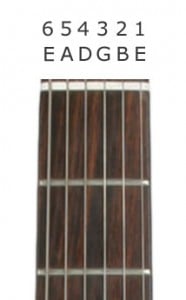
Strings are numbered from the thinnest string (1st string) to the thickest (6th string). The tuning is given from the 6th string to the 1st string: E-A-D-G-B-E. This tuning (E-A-D-G-B-E) is called standard tuning.
Notes are named using the first seven letters of the alphabet, however there are more than seven pitches, or notes, produced on the guitar. The note names, or letters, repeat themselves. For example: the note
name after G is A: … E-F-G-A-B-C-D-E-F-G-A-B-C …
Fret Numbering
Frets are numbered from the headstock toward the body starting with 1. Sometimes the number 0 or letter O is used to denote an open string, or one that is played without fretting a note.
Fretting a note is executed by pressing the string down behind a fret (on the headstock side of the fret).

Fretboard Movement
Guitarists can move horizontally up or down the fretboard, or vertically across the fretboard. These are common terms used to communicate how to shift your hands when playing the guitar.

Fretboard Note Locations
This section will show you where each note on the guitar can be played. The notation is given for completeness. I have a lesson on reading standard notation and tablature if you want more information.
1st String Notes (High E String)


2nd String Notes (B String)


3rd String Notes (G String)


4th String Notes (D String)


5th String (A String)


6th String (E String)


Notation of All the Notes
The following notation and tablature shows the full range of the guitar in standard tuning.
Some notes can only be played at 1 location while others can be played in up to 5 locations.
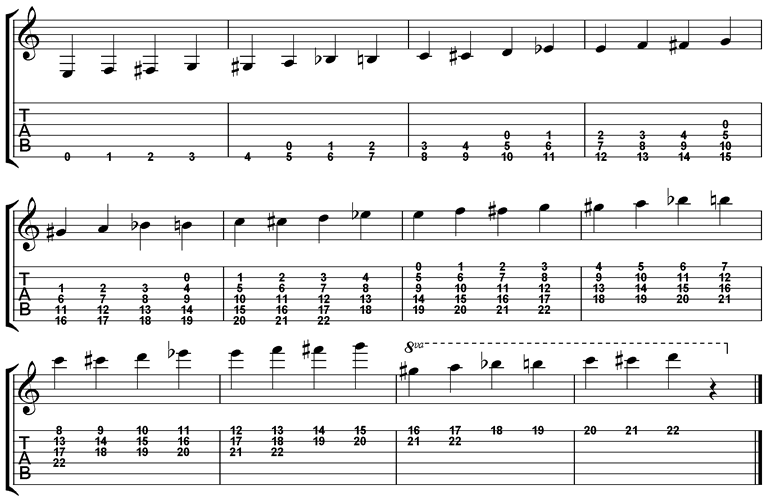
Ascending Descending Exercises
These are simple exercises, but you want to try several things as you play them.
- Hide the tablature as you play. Only show the notation (so you can’t cheat).
- Don’t use one finger for all the notes. Find the fewest hand shifts possible.
- You will notice that I used quarter notes for B-C and E-F. These are a semitone apart. I used half notes when the interval is a whole step (2 semitones). This should reinforce the different intervals.
- Say the notes as your play them to associate the name with the note.
- Watch your fretting hand as you say and play the notes.
- Listen to the notes. Try to memorize their sound along with the feeling of fretting in that position.
- Try listening with your eyes shut and with your eyes on the frets.
- Notice how the dots on your fretboard correspond to each note.
- Use a metronome at 60bpm (1 second per beat). Increase the speed by intervals of 20bpm each time you go through it. See how fast you can play it cleanly. Go slower if you are getting sloppy so you don’t form bad habits.
6th String Notes Ascending
I recommend shifting your hand from open/first position to 5th position, 10th position, 15th, and 19th. Feel free to try other hand shifts to change it up.

6th String Notes Descending
Once again, try various hand shift locations.

Major Chords Rooted on the 6th String

5th String Notes Ascending

5th String Notes Descending

5th String Major Chords Ascending
Play these chords ascending then descending.

Other Ascending and Descending Exercises
I’ll leave these ones for you to figure out, which is a great mental exercise in itself.
- You’ll notice that I used the major chords in the E and A form. Try playing the diatonic chord sequence in the Key of C: CMaj, Dm, Em, FMaj, GMaj, Am, Bdim. For example, replace EMaj with Em. Although diatonic harmony is a topic of its own, I am defining it for these exercises as the chords that use the notes of the major scale. In this case the C major scale.
- Change the chords to the diatonic seventh chords in the Key of C from the E and A forms: CM7, Dm7, Em7, FM7, G7, Am7, Bm7b5.
- Because chords are constructed on thirds (major and minor third intervals), try playing in thirds (every other note on a string) so you know the notes of a chord along a string. This works for all diatonic chords in a key. Let’s take E minor 7 for an example: E-(skip F)-G-(skip A)-B-(skip C)-D. The Em7 notes are E G B D. If you want Em, skip the last note. I love this exercise. It teaches so many nuances of music at once.
More Exercises
 Here are just a few additional exercises that you can use.
Here are just a few additional exercises that you can use.
- Play a note then play its octave on the same string (12 frets up). Repeat this for all the notes.
- Play a note then play the same note on an adjacent string. Example. A on the 5th string, open; A on the 6th string, 5th fret.
- Play a note then play its octave on an adjacent string. Example E on the 6th string, open; E on the 5th string, 7th fret.
- Play a note then play its octave two strings away. Example: E on the 6th string, open; E on the 4th string, 2nd fret. Notice how these octaves are used in the chord forms that you know.
- Play a chord and identify the root notes in that chord.
There are a lot more exercises, which is why I’m offering a book to organize it all so you can focus on learning the fretboard quickly! It contains 159 exercises to keep your practice sessions fresh. It incorporates music theory, chords, and much more so you’re learning multiple concepts at once. I still use these exercises to stay fresh. They work for beginners to pros. Consider buying my book, The Secrets of Learning the Fretboard!
Final Thoughts
I hope you enjoyed this lesson on Learning the fretboard. It takes a lot of practice, but staying motivated seems to be the #1 problem. There are a lot of fun ways to practice the guitar. Keeping your practice fresh with varied exercises is the best way. Once you accomplish it, you’ll break out of ruts and have a lot more fun with the guitar!
If this lesson helped you, please like my brand new facebook page and consider posting about how it helped you.



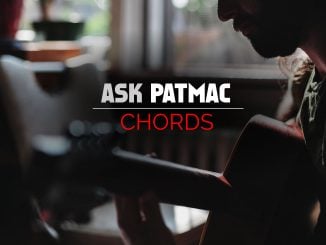
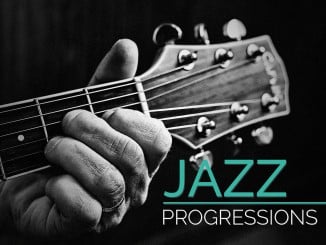
Oh my god this is so helpful! Thankyou!!
Thank you
Re the chords…are you suggesting playing the chords and naming the notes vertically that are in the chords?
Joey, Thanks for the question. To learn the fretboard, I usually focus on root note first. That is the most important because it is how you find your chord on the fretboard. If you have that down, I like to know the lowest pitched note (even if it isn’t the root). This can be useful for playing a bass line (especially in solo guitar arrangements). Lastly, I like to know the highest pitched note of the chord. This is often used as a note in the melody. Obviously, you can practice learning in different ways. I hope this helps to answer your question!
I’ve spent 2 hours looking for this info, thanx a million.
thanx for helping me a lot
This is good, it is going to help me a lot. I’ve been struggling with finding notes fast. I was working with a formula but it was way too slow. I’ll practice these exercises, I believe it’s the breakthrough I need. Thanks again.
Thanks for the help! I was wondering, when reading guitar music how do you know what note to play when there are multiple places to play that note?
Thank you for the question. The correct location is not always specified. If you have tablature with the notation, the location will be noted there. Sometimes, a playing position will be noted. For example, fifth position. If it is not specified, it is up to you to find the best place for you to play it. There is usually a location that is easiest to play. I hope this helps!
As inspiring as you are to help people learn to play the guitar… I too wish to inspire you. I almost gave up! Yep, I almost gave up trying to learn, but your website and simple information have inspired me to stick with it.
Thank you!
Randy, I am glad to hear it! Keep on strumming!
when learning the notes on the frets, is it ok to label them on the guitarto make it easier to remember?
A visual tool like that may be helpful to some at first, but you shouldn’t make it permanent (in my opinion). At some point, you need to have instant recall without the labels. It’s like using your fingers to do math. It can help, but you want to do the math in your head for the fastest results.
Patrick,
I am currently taking guitar lessons ( I waited until I retired to start) lol! My ambition in taking lessons is to be able to put music to songs I have written and intend to write in the future. Is there a more specific path that I should focus on if my goal is say more toward melody for my songs than playing lead guitar. My instructor leans more toward lead guitar.
You are not alone! Many start guitar or restart their learning in retirement. When you say you want to focus on melody and not lead, I assume this means that you want to understand the note choices of your melody. Lead guitar can do this, but it can also be an exercise in getting fast or simply choosing the right scale. Learn chord construction, learn scales, learn the fretboard. It works together by knowing the notes that work with the chords/harmony and being able to play them instantly across the fretboard. So I’ll ask you to read my free chord construction lesson then consider buying my book, The Secrets of Learning the Fretboard. The chord construction lesson will introduce the core topics of harmony and relate it to the major scale. My book will help you find your note options in a way that helps you think about the notes (and recall them as quickly as possible). I hope this helps.
Thanks for this. It helps. I have a question I hope I can make it clear though. If you are playing two notes on the E and B string, lets say the 12th and 10 fret respectively. What is the easiest way to transfer them over a string set to the B and G strings? I can do it with time but is there a way to think about it? Is it 5 frets down or 7 frets down? I used to know this but it has escaped me. Thanks.
It is 5 frets unless switching between B and G strings. So if you’re going to “higher numbered – thicker strings” you go to higher frets by 5 unless you are going from B to G string – which is 4 frets. If you are going down in strings (to a thinner string) you move to a lower fret number.
In your example, you’d move to 14 on the G string and 17 on the B string.
I hope this helps.
Thank you so much. This is really helpful…!!!!
You’re welcome. Thank you for the kind words.